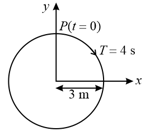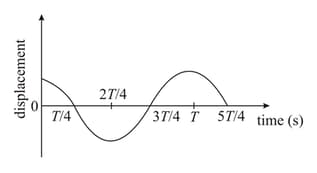MEDIUM
Earn 100
A particle performing SHM has time period and path length 4 cm. The displacement from mean position at which acceleration is equal to velocity is
(a)Zero
(b)0.5 cm
(c)1 cm
(d)1.5 cm
47.27% studentsanswered this correctly
Important Questions on Oscillations
MEDIUM
EASY
MEDIUM
EASY
MEDIUM
The position co-ordinates of a particle moving in a coordinate system is given by
and
The speed of the particle is:
EASY
Which one of the following graph shows correctly the variation with ?
MEDIUM
MEDIUM
HARD
HARD
HARD
EASY
HARD
EASY

-projection of the radius vector of rotating particle is
MEDIUM
The displacement time graph of a particle executing SHM is given in figure: (sketch is schematic and not to scale)

Which of the following statements is/are true for this motion?
(A) The force is zero at
(B) The magnitude of acceleration is maximum at
(C) The speed is maximum at
(D) The is equal to of the oscillation at
EASY
EASY
HARD
EASY
EASY

